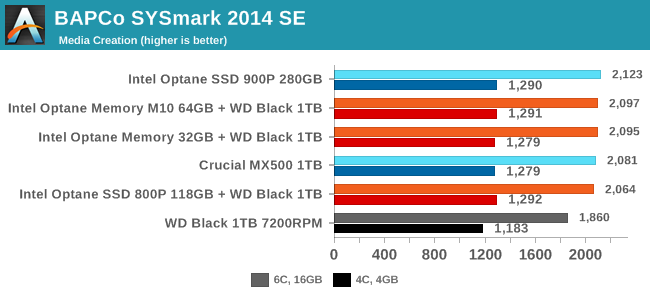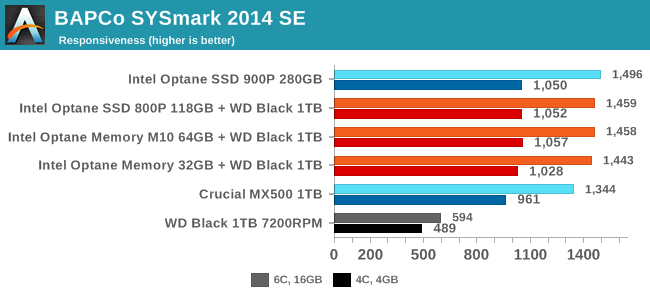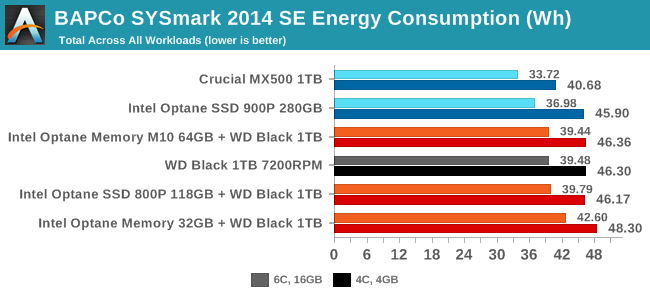The Intel Optane Memory M10 (64GB) Review: Optane Caching Refreshed
by Billy Tallis on May 15, 2018 10:45 AM EST- Posted in
- SSDs
- Storage
- Intel
- PCIe SSD
- SSD Caching
- M.2
- NVMe
- Optane
- Optane Memory
BAPCo SYSmark 2014 SE
BAPCo's SYSmark 2014 SE is an application-based benchmark that uses real-world applications to replay usage patterns of business users in the areas of office productivity, media creation and data/financial analysis. In addition, it also addresses the responsiveness aspect which deals with user experience as related to application and file launches, multi-tasking etc. Scores are calibrated against a reference system that is defined to score 1000 in each of the scenarios. A score of, say, 2000, would imply that the system under test is twice as fast as the reference system.
SYSmark scores are based on total application response time as seen by the user, including not only storage latency but time spent by the processor. This means there's a limit to how much a storage improvement could possibly increase scores, because the SSD is only in use for a small fraction of the total test duration. This is a significant difference from our ATSB tests where only the storage portion of the workload is replicated and disk idle times are cut short to a maximum of 25ms.
For this review, SYSmark has been used on two different machines: a relatively high-end system with a six-core Intel Core i7-8700K processor and 16GB of RAM, and a more limited system with a quad-core Intel Core i5-7400 processor and just 4GB of RAM. The low-end system spends a lot of time swapping thanks to its small amount of RAM, and this adds greatly to the storage workload.
| AnandTech SYSmark SSD Testbed | |
| CPU | Intel Core i7-8700K |
| Motherboard | Gigabyte Aorus H370 Gaming 3 WiFi |
| Chipset | Intel H370 |
| Memory | 2x 8GB Kingston DDR4-2666 |
| Case | In Win C583 |
| Power Supply | Cooler Master G550M |
| OS | Windows 10 64-bit, version 1709 |
| AnandTech SYSmark SSD Low-End Testbed | |
| CPU | Intel Core i5-7400 |
| Motherboard | ASUS PRIME Z270-A |
| Chipset | Intel Z270 |
| Memory | 1x 4GB Corsair DDR4-2666 |
| Case | In Win C583 |
| Power Supply | Cooler Master G550M |
| OS | Windows 10 64-bit, version 1709 |
None of the Optane Memory modules are large enough to serve as a Windows boot drive alone as well as storing all the applications used for SYSmark, so this section only tests the Optane Memory and Optane SSD 800P as cache drives. (The 118GB Optane SSD 800P is pretty much the smallest drive that can could run SYSmark, but it doesn't leave much room for user data.)



The Data/Financial Analysis, Media Creation, and Office Productivity sub-tests are all relatively insensitive to storage performance, and they are shown in order of decreasing sensitivity to the CPU and RAM differences between the two test systems. These results show that a mechanical hard drive can hold back application performance, but almost any solid state storage system—including Optane Memory caching—is sufficient to shift the bottlenecks over to compute and memory.

The Responsiveness test is less focused on overall computational throughput and more on those annoying delays that make a computer feel slow: application launching, opening and saving files, and a variety of multitasking scenarios. Here, moving off a mechanical hard drive is by far the best upgrade that can be made to improve system performance. Going beyond a mainstream SATA SSD provides diminishing returns, but there is a measurable difference between the SATA SSD and the fastest Optane SSD.
Energy Usage
The SYSmark energy usage scores measure total system power consumption, excluding the display. Our SYSmark test system idles at around 26 W and peaks at over 60 W measured at the wall during the benchmark run. SATA SSDs seldom exceed 5 W and idle at a fraction of a watt, and the SSDs spend most of the test idle. This means the energy usage scores will inevitably be very close. A typical notebook system will tend to be better optimized for power efficiency than this desktop system, so the SSD would account for a much larger portion of the total and the score difference between SSDs would be more noticeable.

The Intel Optane SSD 900P is quite power-hungry by SSD standards, but running a hard drive is even worse. The Optane Memory M10 and 118GB 800P further add to power consumption when used as cache devices, but they speed up the test enough that total energy usage is not significantly affected. The 32GB Optane Memory doesn't offer as much of a performance boost, and it lacks the power management capabilities of the more recent Optane M.2 drives.










96 Comments
View All Comments
FunBunny2 - Wednesday, May 16, 2018 - link
one of the distinguishing points, so to speak, of XPoint is its byte-addressable protocol. but I've found nothing about the advantages, or whether (it seems so) OS has to be (heavily?) modified to support such files. anyone know?Billy Tallis - Wednesday, May 16, 2018 - link
The byte-addressability doesn't provide any direct advantages when the memory is put behind a block-oriented storage protocol like NVMe. But it does simplify the internal management the SSD needs to do, because modifying a chunk of data doesn't require re-writing other stuff that isn't changing. NVDIMMs will provide a more direct interface to 3D XPoint, and that's where the OS and applications need to be heavily modified.zodiacfml - Friday, May 18, 2018 - link
Quite impressive but for 32GB Optane drive, I can have a 250 GB SSD.The Optane might improve performance for fractions of a second over SSDs for applications but it won't help during program/driver installations or Windows updates which needs more speed.
I'd reconsider it for a 64 GB Optane as a boot drive for the current price of the 32GB.
RagnarAntonisen - Sunday, May 20, 2018 - link
You've got to feel for Intel. They spend a tonne of cash on projects like Larrabee, Itanium and Optane and the market and tech reviewers mostly respond with a shrug.And then everyone complains they're being complacent when it comes to CPU design. Mind you they clearly were - CPU performances increased at a glacial rate until AMD released a competitive product and then there was a big jump from 4 cores to 6 in mainstream CPUs with Coffee Lake. Still if the competition was so far behind you can afford to direct to R&D dollars to other areas.
Still it all seems a bit unfair - Intel get criticised when they try something new and when they don't.
And Itanium, Larrabee and Optane all looked like good ideas on paper. It was only when they had a product that it became clear that it wasn't competitive.
Adramtech - Sunday, May 20, 2018 - link
since when is a 1st or 2nd Gen product competitive? I'm sure if they don't have a path to reach competitiveness, the project will be scrapped.Keljian - Tuesday, May 29, 2018 - link
While I don't doubt the tests are valid, I would really like to see a test with say PrimoCache - with the blocksize set to 4k. I have found in my own testing that Optane (with PrimoCache using optane as an L2 @ 4k) is very worthwhile even for my Samsung 950 pro.Keljian - Tuesday, May 29, 2018 - link
https://hardforum.com/threads/intel-900p-optane-wo... - Here are my benchmark findings for the 850 evo and 950 pro using the 32gb optane as L2 cache. You'll notice the 4k speeds stand out.denywinarto - Tuesday, May 29, 2018 - link
Thinking of using this with 12 tb hgst for a gamedisk drive for a ISCSI-based server, the data read is usually the same as they only game files. But occasionally new game gets added. Would it be a better option compared to raid? SSD are too expensive.Lolimaster - Monday, October 1, 2018 - link
Nice to use the 16GB as pagefile, chrome/firefox profile/cacheLolimaster - Tuesday, October 2, 2018 - link
It's better to use them as extra ram/pagefile or scratch disk.